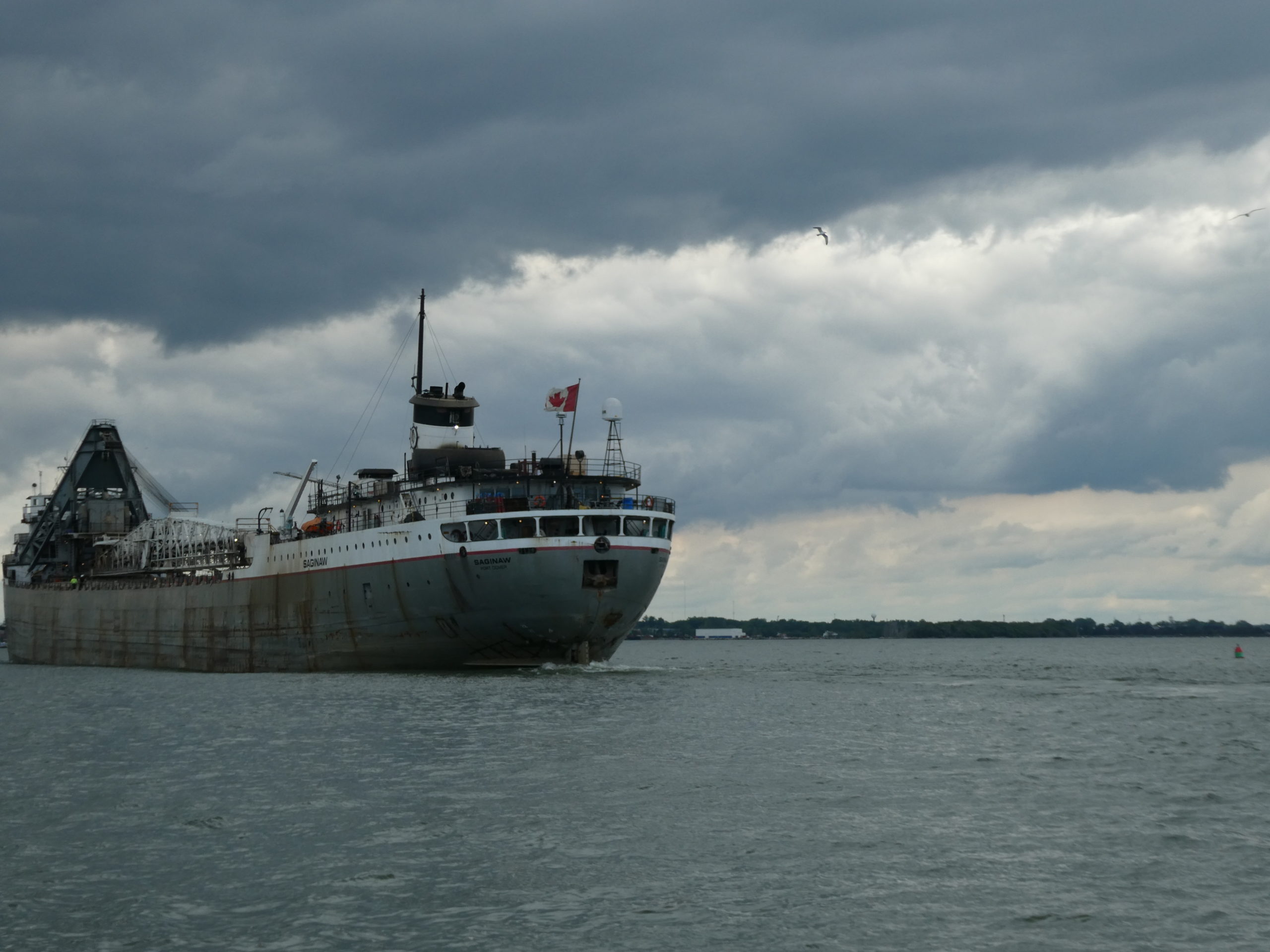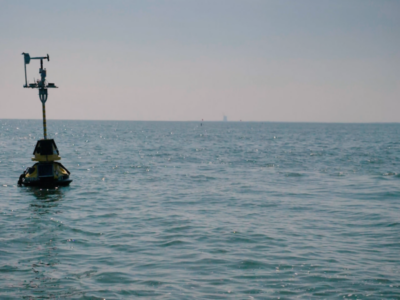
A common question for casual observers of Great Lakes vessels is “Where are the big container ships?” The reference is to the massive ocean-traversing ships with containers stacked stories high.
The container ships have been absent from the Great Lakes where cherished lake freighters dominate the waterways hauling bulk cargo.
But that absence could be a thing of the past as there are moves afoot that could bring container ships, at least a smaller version of them, to the lakes.

James Weakley (Photo Credit: American Maritime Partnership via James Weakley)
Great Lakes Now’s Gary Wilson recently spoke with veteran Great Lakes shipping executive James Weakley about the nascent move to container shipping on the lakes.
Weakley, a retired U.S. Coast Guard officer, has been president of the Great Lakes shipping industry group the Lake Carriers’ Association since 2003. He is the current president of the Great Lakes Maritime Task Force.
Weakley explained the economic and logistical barriers to container shipping on the Great Lakes and the roles the ports of Cleveland and Duluth may play. Duluth comes with unique geographic challenges that Weakley said can also be benefits.
In a candid exchange, Weakley laid out the commercial shipping disadvantages the Great Lakes face based on the low priority the federal government gives to the ice-breaking needs of the Great Lakes region.
The interview was conducted via phone and email and was recorded, transcribed and edited for clarity and length.
Great Lakes Now: A recent column in the industry publication The Maritime Executive said there is a renewed interest in expanding container shipments to Great Lakes ports like Cleveland and Duluth. We’re used to seeing the lake freighters that carry bulk commodities like iron ore and other industrial material. What’s prompting the interest in containerized commodities?
James Weakley: There are a couple of things prompting the interest. First, let me say, the interest in containerized shipping is great for the Great Lakes and for our regional economy.
The congestion at the coastal container ports has been a problem, and it’s getting worse. Particularly with Covid and now, everyone’s more aware of supply chain challenges so there’s a greater sensitivity. And truck congestion exiting the coastal container ports is an issue. I’ll have to give the Port of Cleveland credit because they were ahead of this power curve and were trying to shift containers from the congested coastal ports to the Midwest years ahead of the current challenges.
GLN: To your point, the Port of Cleveland started working on this in 2014 when it made a significant investment that allowed it to receive container ships. How did that come about?
JW: Containers for at least the 20 years I’ve been in the industry have been the unicorns of Great Lakes shipping. People wonder why there are not more containers moving on the Great Lakes, especially domestically. The answer is the speed of the different transport modes and the value of the cargo. Lake freighters move bulk cargo, which makes sense because it’s low-value cargo that can be used in large quantities at one time.
Containers usually contain higher value cargo, so having that cargo sit is costing someone money. Cleveland recognized that there was congestion at the coastal ports and on the I-95 corridor. So when cargo from Europe lands in Baltimore, Philadelphia and New York, it will sit on the dock until a truck is available to move it to its final destination.
Cleveland realized it needed to subsidize the trade to get it going. That came from public money and once they proved it was viable and that there was a reliable supply chain, they could reduce the subsidy and now it is sustained on its own.
GLN: The Port of Duluth is seen as a candidate to ship bulk agricultural commodities like wheat, barley and oats in containers to overseas destinations. Given its western Great Lakes location, are there additional logistical challenges that an eastern port like Cleveland doesn’t face?
JW: Yes, but those challenges are also benefits. The Port of Duluth has a different market. It can feed the Minneapolis market and markets in Canada. The challenge is the backhaul. If you can have a ship full in two directions, you can offset the cost of that ship by the revenue generated in both directions. The genius of what the Port of Duluth is doing is they’re putting agricultural products in containers and allowing that to be the backhaul for the container ships.
That encourages the container ships to go the increased distance to Duluth with European exports and provides an American export for that backhaul leg. It’s a different market segment from Cleveland because of the geographic radius and because of that backhaul offered to the carrier.

A freighter in the Straits of Mackinac. (Photo courtesy of Storyblocks)
GLN: The Maritime Executive article said that high fuel prices sparked the interest in container shipments. But the price of fuel ebbs and flows over time. Is there a risk that Great Lakes ports could invest in receiving and dispatching container ships but then have the market dry up if fuel prices decline?
JW: There is that risk, but I’d say it’s a small risk. The biggest challenge of containerization on the Great Lakes is seasonality. Some supply chains need a year-round supply, and the Great Lakes can only offer 9 or 10 months because of freezing conditions.
GLN: If containerized shipping expands to Great Lakes ports, is there a potential impact on the lake freighters that have long sailed the lakes?
JW: Let me say when container shipping expands, because I’m optimistic it will, it will be complementary to the lake freighters.
The biggest conflict is the congestion of the waterways particularly around the Soo Locks. This year we saw the McArthur Lock delayed in its opening and that was a significant challenge. Ice-breaking is a big challenge too, but I’m not sure there will be a lot of container ships moving during the ice-breaking season.
GLN: Cruise ships have returned to the Great Lakes, the traditional lake freighters continue, and we may now have ocean-going container ships plying Great Lakes waters. Does the increase in commerce also come with an increased risk to what is already a fragile ecology? Aquatic invasive species are still an issue and the aged Line 5 oil pipeline in the Straits of Mackinac remains an unresolved threat.
JW: That’s a fair question and I’ll take them separately. There will always be tradeoffs, particularly with risks and there probably is an increased risk.
The question is what is that risk. I would argue that it’s a small risk because people have estimated that our current waterway use during the navigation season, not the ice season, is probably about 50% of what it could be. We could absorb significantly larger amounts of traffic.
Keep in mind that all those foreign ships, particularly the cruise ships and those container ships, have American pilots on board and in some waters, Canadian pilots. The pilots are providing expertise to those foreign vessels who aren’t familiar with our waters so that reduces the risk.
There have been no new invasive species via ballast water since 2006. And during that same timeframe there have been no documented movement or spread of invasive species via ballast water. So the track record is pretty good on ballast water.
The risks have been reduced, but I wouldn’t say they’ve been eliminated because we’re talking about risks. But clearly the introductions and spread have been eliminated when the Bloody Red Shrimp was the last one introduced.
GLN: As a shipping industry executive, you have lobbied for new icebreakers for the Great Lakes for years, but the Coast Guard’s support was lacking and Congress has been slow to react. Has there been progress on securing a new icebreaker or does the region have to live with what it has?
JW: There’s been tremendous political progress, and by political progress, I mean that the Great Lakes congressional delegation is 100% onboard and when that happens, things can move.
The previous commandant of the Coast Guard told the senate Commerce Committee that he absolutely supported funding for a Great Lakes icebreaker. The new commandant, in her confirmation hearing, affirmed her support for a Great Lakes icebreaker.
Why is that? Because I think we have six Great Lakes members on the Commerce Committee that oversaw her confirmation hearing.
So, there’s been an internal shift in the winds within the Coast Guard, but the challenge is getting it funded. It’s not in the president’s budget, so it will take time for that to happen. We’re fighting hard to get it funded in the Build Back Better bill.

Poe Lock under repair (Great Lakes Now Episode 1011)
GLN: You were quoted in May saying that when a cargo ship gets stuck in the Chesapeake Bay or the Suez Canal, it draws worldwide attention. But those are regular occurrences on the Great Lakes due to insufficient icebreaking capabilities. How can the region elevate the importance of maritime commerce on the Great Lakes so it doesn’t have to endure periods of protracted political wrangling for resources like icebreakers?
JW: Sadly, the Great Lakes Region is not understood and is often disrespected by those policy makers from outside of our region. I have personally experienced this with both the Army Corp of Engineers and the Coast Guard for decades.
People from the coasts visit the Great Lakes and wonder why they can’t see the other side. Administrations tend to pay attention to the region during presidential campaigns and often move on after the election.
Just as we saw strong internal resistance with the Army Corps’ headquarters staffers, I fear Coast Guard headquarters still has the same attitude with regard to both Great Lakes ice breaking policy and building a new heavy icebreaker for the region. The East Coast has twenty-five Coast Guard icebreaking assets, and we have nine – and keep in mind that ice breaking is easier on the East Coast due to salt water, tidal flow and warmer temperatures.
Fortunately, when our Congressional delegation is on the same page, we can get things done. We have seen that with the dredging crisis, new Soo Lock and the Great Lakes Restoration Initiative.
We have done all we can with the Coast Guard and now must take our case to Congress and the public. There are direct consequences for the public from inaction on icebreaking. Witness the 2021 ice-dam induced flooding along the St. Clair River.
GLN: To great fanfare in January, it was announced that Congress fully funded the new Soo Lock that for years Michigan and the region had been clamoring for. Then in May, the Army Corps of Engineers said the cost of the project could double or triple. What’s the project’s status today?
JW: It was a gut punch when the region heard about the increased cost and in fairness to the Army Corps, the price of steel alone has tripled since 2018 when the project’s costs were estimated. What we’re seeing is rampant inflation and it’s not just Army Corps projects, it’s all construction projects.
Funding and implementation of big federal projects like the new Soo Lock is a complicated, bureaucratic process that necessarily moves at its own pace. That’s why advocates for the new Soo Lock were caught off guard when the cost increases were announced.
The status of the project is that Phase 3, which is construction of the new lock chamber itself and is the final phase, is going forward. There are other economic hurdles to be dealt with in the coming years, but they are likely manageable.
Catch more news on Great Lakes Now:
Coast Guard: Oil spill closes shipping on St. Mary’s River
The 2022 Great Lakes shipping season sets sail after COVID-19 hurdles
Sustainable Shipping: Burns Harbor port tries to green Indiana’s industrial coast
Featured image: Freighter on Lake Erie (Photo Credit: Natasha Blakely)




